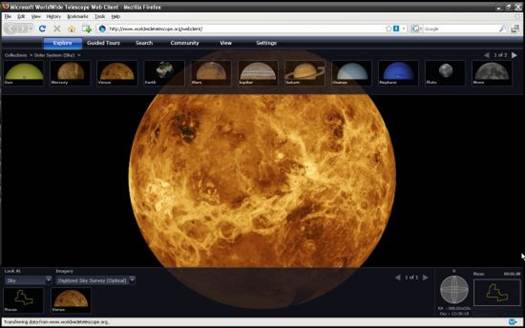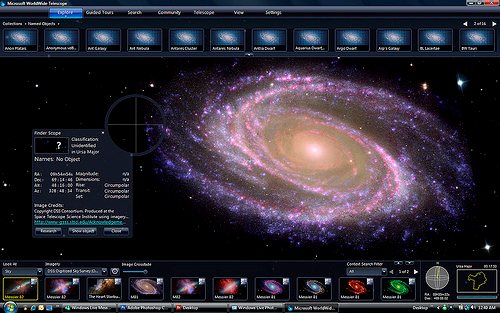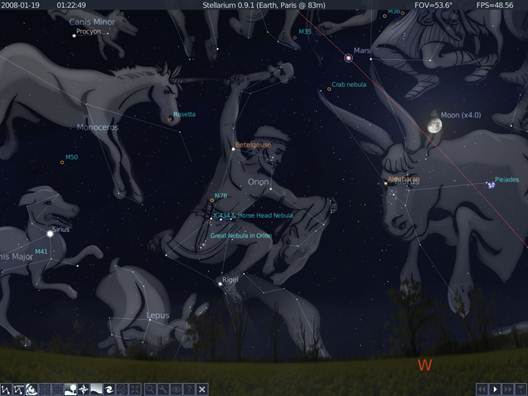A clear winter's evening is an ideal
time to partake in a spot of amateur sky gazing. We drag our telescope from its
allotted place in the cupboard, and takes a look at some of the best free,
amateur astronomy apps out there
WorldWide Telescope
Details
·
Price: Free
·
Manufacturer: Microsoft Research Centre
·
Website: www.worldwidetelescope.org/Home.aspx
·
Required Spec: XP SP2 and above, 1GB RAM, 3D
Accelerated card with 128MB, 10GB HDD space, DirectX 9.0c & .NET

Microsoft's
WorldWide Telescope is a bit like Google Earth or (Virtual Earth) for the sky.
Microsoft’s WorldWide Telescope (WWT) is a
relative newcomer to the astronomical software collection, and as a consequence
comes across as being a well-developed and modern interface through which to
explore the universe.
WWT is a free helping from Microsoft which
lets the user view the solar system, universe and all the items within in
glorious 3D. The impressive content comes from the likes of the Hubble Space
Telescope, NASA ’s Spitzer Space Telescope, the Chandra X-Ray Observatory
Centre, the Sloan Digital Sky Survey, and approximately ten other Earth-bound
telescopes from around the globe.
The main WWT window comprises of,
initially, a confusing wealth of tabs, icons and tiles with the telescope view
in the centre portion of the screen displaying our solar system from some
distance out. From here it’s purely up to the user as to where to go next; for
example, clicking one of the named planet tiles along the bottom of the screen,
Earth for instance, will zoom into the planet by way of a pleasing whizz
through the outer to inner solar system. The planet will then be displayed in a
3D model, much in the same vein as Microsoft Virtual Earth or Google Earth. In this
planet mode, you can zoom into the landscape through the collective satellite
imagery, or via a panorama mode that covers the Apollo landing sites, Mars
Pathfinder, Spirit and Opportunity, with Curiosity data to be released soon.

With
great graphics though, it’s easy to become distracted
Taking a wider field of view, you are able
to use the mouse wheel, or connected Xbox controller, to zoom in and out of the
local bodies to the visible, known universe, and by right-clicking on any area
of the sky you are afforded a pop-up information box, or Finder Scope,
detailing the right ascension, declination, altitude and azimuth as seen from a
selected point on the Earth, which can be altered from the Settings tab.
The attention to detail in WWT is quite an
achievement, by using the Microsoft High Performance Visual Experience Engine
technologies terabytes of images and data can be blended into a single
application, or through a web browser and Silverlight. As a virtual telescope
WWT excels, with its list of features and modes. However, the user can also
connect their own telescope, and use WWT to control and find objects. Layers
can be created, detailing visualized data from user input into 3D models.
Planetary geology can be analysed and displayed along with astrophotography,
sky surveys, background cosmic radiation analysis. The solar system can be
viewed as it was from 1AD up to 4000AD, including asteroid, spacecraft and
orbital objects paths.
WWT has something for every level of
amateur astronomy, from school homework to deep space observations. However, it
does tend to drown in its own feature list at times, and when viewing an object
one wrong click can annoyingly send you travelling to another section of the
sky.
Providing you take your time, review the
features slowly or you have a specific need, then WWT is the must-have
application for the garden astronomer. The sheer number of extras you can delve
into is, quite frankly, amazing and as an added bonus logging into your
Microsoft Live account offers you the chance to collaborate and share your
findings and data with the other several million users of WWT, as well as
statistical data from observatories and universities from around the world.
It’s an impressive program that Microsoft
has created here, and possibly one of the best applications it has ever
developed. But it’s as big as the cosmos it allows you to view, so be prepared
to become very lost at times.
Verdict
·
Quality: 8
·
Value: 9
·
Overall: 8
Stellarium
Details
·
Price: Free
·
Manufacturer: Fabien Chéreau
·
Website: www.stellarium.org
·
Required Spec: Linux, Windows XP above, Mac OSX
10.3 above, 1GB RAM, 3D graphics with OpenGL

Stellarium
0.10.0 (SVN) with a couple of the new GUI elements visible
A firm favourite of open source users since
its initial release back in 2001, Stellarium successfully displays over 600,000
stars from the Hipparcos and Tycho-2 Catalogues, with the option to download
many hundreds of millions more from within its settings.
Developed as a planetarium for the naked
eye, binoculars or a small telescope, it’s a wonderful application that offers
the user the ability to view the positions of the objects in the night sky
without over-complicating, overwhelming, or spoiling the fun of ground-based
observations with grandiose 3D fly-bys and fancy graphics. That doesn’t mean to
say Stellarium is void of pleasing graphical splendour, quite the opposite in
fact, it’s just a little more academic than the competition.
To the uninitiated getting Stellarium up
and running, with a view to the sky from your part of the world can be a bit
daunting. The initial menus are hidden in the bottom right of the screen, going
up and across, and can be brought up by moving the mouse into the lower right.
From here, using the vertical menu, you can set the location of the observer,
from anywhere on the globe, set the date and time, set the sky and viewing
options, search for objects, alter the settings and bring up the help. From the
horizontal menu you can enable, or disable labels and graphics displaying the
constellations, equatorial and azimuthal grids, show/hide the landscape,
cardinal points, atmosphere, centre on object and set the time rate.

Stellarium
is big, bold and beautiful
The configuration menu, via the vertical
menu, allows the user to further customize their Stellarium experience by
additional plug-ins, scripts and tools. The aforementioned star catalogue
updates are available for download, each in the region of 600MB but containing
the data of millions of stars. The scripts section offers detailed,
user-created scripts that present a custom presentation, be that a Martian
eclipse with Phobos, or a supernova as observed by Tycho Brahe in 1572. The
Plug-ins provide numerous extra enhancements, such as an angle measurement
tool, or labels showing the position of the, so far, recorded exoplanets from
the Extrasolar Planets Encyclopaedia.
Of course, with a little experience the
user themselves can create their own unique scripts or plug-ins, which
potentially makes Stellarium a more powerful application than the others on
test here but there’s a significant learning curve before achieving this.
Thankfully, with Stellarium being around for as long as it has, and the fact
that it’s well received within the open source community, there’s no shortage
of user created guides, skins and other additions which can be installed and
read to make Stellarium a more user-friendly interface.
Once you get to know your way around
Stellarium the information it can offer will greatly benefit the amateur
astronomer, especially since Stellarium is available for Windows, Mac and
Linux. With the activation othe an additional telescope plug-in, Stellarium is
also able to control a 'scope via a computerised mount, sending Go To commands to
the unit. This makes Stellarium the perfect application for small, less
powerful laptops that are ideal to take out on expeditions, yet can be used as
control positioning hardware for motorised scopes.
Selecting an object will display all the
relevant positional data, and the ability to zoom into the target object makes
for a slightly more interesting addition, but as already stated what Stellarium
may lack in distracting graphics, it gains in a more mature and academic
feature set. In short, Stellarium is the ideal companion for those whose
passion is to gaze at the universe.
Verdict
·
Quality: 9
·
Value: 9
·
Overall: 9